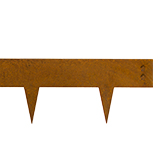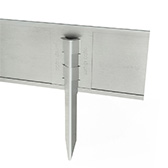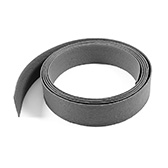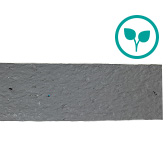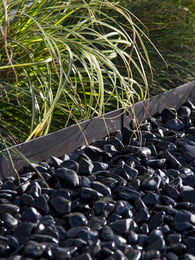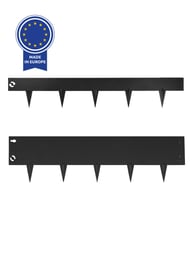
Lawn & Garden edging
A garden with beautifully finished borders is within reach with the help of our lawn and garden edging products. With edging, also known as border or border edge, you can quickly and neatly seperate your lawn, flowerbed, or gravel path from the rest of your garden. All our lawn and garden edging product are produced by one brand: Multi-Edge. Available in several plastic variants and several metal variants. For information, frequently asked questions, and advice on edging, you can find this at the bottom of this page, under the products.
What is lawn edging and garden edging?
Lawn edging and garden edging are terms for all kinds of materials that can be used as a physical demarcation of different areas in your garden. It is also called 'border edge'. Edging provides a nice finish to your garden. Additionally, it has practical benefits. It keeps materials such as gravel, mulch, paving, and other elements in place. For example, edging prevents gravel from rolling off the path into the garden (or vice versa). There are several advantages to using edging. We have listed these advantages of edging for you:
- Lawn and garden edging beautifully defines your garden or parts of your garden, giving it a neat and classy appearance.
- Lawn and garden edging ensures that you don't see edges of, for example, artificial grass or the lawn.
- Lawn and garden edging keeps everything in place. For instance, when you create a gravel path and border it, the edging prevents the gravel from rolling off when you enter the path.
- Lawn and garden edging also keeps plants in place. For example, if you have creeping plants in your garden and border them with edging, you prevent the plants from easily growing over your garden path.
When is it advisable to use edging?
There are several situations in which edging is a useful addition:
Artificial Grass
When installing artificial grass, the edging hides the often less decorative edges of artificial grass. The edging can serve as a separation between the artificial grass and the decorative garden or your garden path. It also provides protection against strong winds and heavy rainfall.
Natural Grass Lawn
Even when creating a lawn wit natural grass instead of artificial grass, edging offers advantages. It covers the often less decorative edge of the lawn and keeps the grass in place. Edging prevents the grass from quickly growing over your garden path or into your decorative garden. It also protects your lawn against strong winds and heavy rainfall.
Gravel paths and terraces
When creating a terrace or garden path with gravel or pebbles, edging is also beneficial. For example, when there is a decorative garden with black soil next to the gravel path, the edging prevents the gravel or pebbles from rolling into the garden.
Driveway / parking area
When creating a driveway or parking area with gravel or pebbles, you can choose to install gravel grids underneath the gravel / pebbles. We recommend edging the borders of the driveway or parking area. This offers two advantages; firstly, like in the case of a gravel path or decorative gardens with gravel, it keeps the stones in place. And secondly, it secures the gravel grids. Do not place the gravel grids tightly against the edging; leave a few centimeters in between. The reason for this is, in case of higer temparatures during summertime, the gravel grids can expand a bit. Without this small gap, they may get damaged.
Vegetable garden or pond
You can also use edging to demarcate your vegetable garden or pond. The garden edging protects your vegetables/fruits against wind/storm.
What types of border edges are available and which type of edging is best for me?
Edging comes in various materials. At Amagard, we have chosen to offer garden and lawn edging made of plastic and steel. Edging made of these materials has some advantages over, for example, concrete; plastic/steel edging is flexible, and the material is much lighter. Both of these qualities make installation easier, and it allows for creating figures and curves.
Steel edging
One of the types of edging you can find in our webshop is steel edging. You can find this under the names Multi-Edge METAL and Multi-Edge ADVANCE. The advantage of this type of edging is that it is very sturdy and has a very modern appearance. The Multi-Edge Metal is available in several variants: galvanized steel, white, black, stainless steel, and Corten steel. The Multi-Edge ADVANCE is made of galvanized steel and Corten steel. Ground pins are already attached to the Multi-Edge METAL. Separate ground pins are not needed. It's very easy to install. The Multi-Edge ADVANCE has a clever coupling and installation system, also making it easy to install. The Multi-Edge ADVANCE is a bit higher than the Multi-Edge METAL.
Corten steel edging
A Corten steel border edge has undergone a special treatment, causing the top layer of the steel to rust. This rusting is limited to the top layer. This creates a distinctive color and an authentic appearance, without compromising the quality.
Plastic edging
In addition, you can also find plastic edging (and plastic border rolls) within our assortment. You will find this type of garden and lawn edging under the names Multi-Edge FLEX and Multi-Edge ECO. Both are mode out of recycled plastic. Plastic border edges are very suitable for creating sharp bends or round shapes.
Which type of garden edging should I buy?
Let's state upfront that both plastic and steel edging are usable in all cases. However, the plastic variants (Multi-Edge FLEX, Multi-Edge ECO) are a bit more flexible. So, if you plan to work with sharp bends and/or round shapes in your garden, we advise you to use the plastic variants. On the other hand, steel edging has a more authentic and modern appearance. So, it pretty much all comes down to your personal preference and the exact application (sharp bends an round shapes).
What is the hight of the garden eding products?
The height of the edging depends on the type:
-
- Multi-Edge METAL (steel edging): the height is 17.5cm, including the attached pins. The height excluding the pins is 7.5cm, of which about 3cm goes into the ground. So, about 4 to 4.5cm is visible above the ground.
- Multi-Edge ADVANCE (steel edging): the height is 20cm. The ground pins are 40cm high (of which 24cm goes into the ground). The edging itself goes at least 10cm into the ground, so there is a maximum of 10cm above the ground.
- Multi-Edge FLEX (plastic edging): the height is 5.5cm or 7cm, depending of which variant (which is completely visible above groud). 4 ground pins are included per meter. With these, you secure the edging in the ground.
- Multi-edge ECO (plastic edging): the height is 14cm. 2/3 of this goes into the ground. This means 5cm is visible above the ground.
How much edging do I need?
For the Multi-Edge ADVANCE, Multi-Edge FLEX, and Multi-Edge ECO, this is equal to the number of linear meters of edging you need. So, if you want to edge 40 linear meters of lawn, you also need 40 meters of edging. For the Multi-Edge METAL, this is a bit different because the pieces of edging overlap slightly when installed. This is due to the coupling system. To calculate how much Multi-Edge METAL you need, divide the number of linear meters of edging you need by 0.95.
Example: You want to edge 40 linear meters of lawn with Multi-Edge METAL. You need to order 40 / 0.95 = 42.11 meters = 43 meters of edging.











